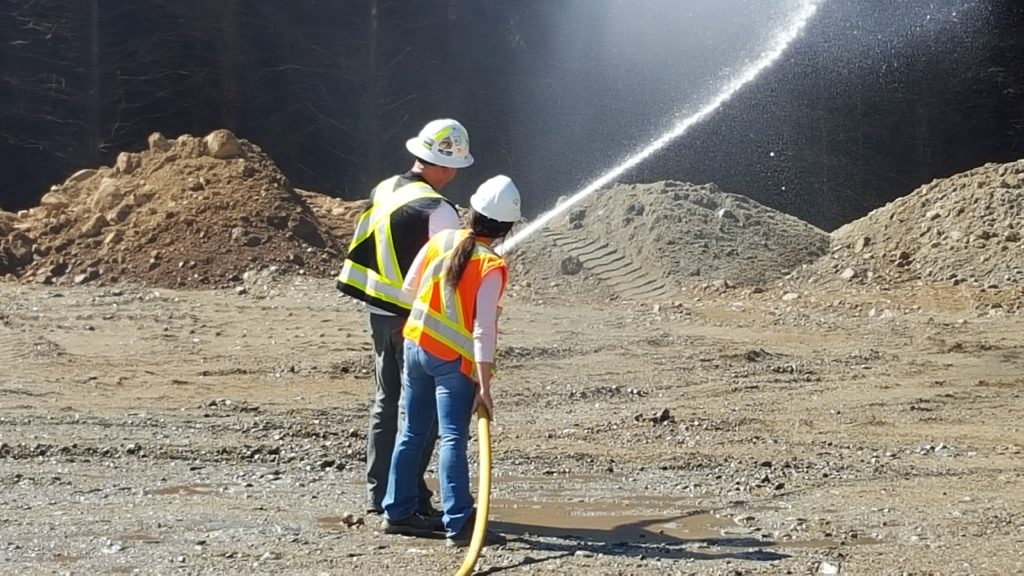Wildfire Prevention For Industry & Commercial Operators

Have you ever wondered what kinds of work you can do during fire season? Once the fire season starts, please stay on top of the kinds of activities you’re safely capable of doing… Here’s the detail:
High Risk Activities
There are three steps to determine your obligations around high risk activities:
Step 1. Find out if your proposed activity is considered a high risk activity. If it is,
Step 2. Find out what the fire danger rating is at your proposed location of operation. Then,
Step 3. Based on what the fire danger rating is, determine whether there are restrictions on high risk activities.
Step 1. What is a high risk activity?
Your first step is to determine if your proposed activity is considered a “high risk activity”.
High risk activities are defined in the Wildfire Regulation under “Definitions“.
In the Wildfire Regulation, high risk activities mean each of the following:
(As per Wildfire Regulation consolidated July 13, 2006)
(a) mechanical brushing;
(b) disk trenching;
(c) preparation or use of explosives;
(d) using fire- or spark-producing tools, including cutting tools;
(e) using or preparing fireworks or pyrotechnics;
(f) grinding, including rail grinding;
(g) mechanical land clearing;
(h) clearing and maintaining rights of way, including grass mowing;
(i) any of the following activities carried out in a cutblock excluding a road, landing, roadside work area or log sort area in the cutblock:
(i) operating a power saw;
(ii) mechanical tree felling, woody debris piling or tree processing, including de-limbing;
(iii) welding;
(iv) portable wood chipping, milling, processing or manufacturing;
(v) skidding logs or log forwarding unless it is improbable that the skidding or forwarding will result in the equipment contacting rock;
(vi) yarding logs using cable systems;
(j) to (q) Repealed. [B.C. Reg. 213/2008, s. 1 (b).]
If you have determined that your proposed activity is listed above as a high risk activity, your next step is to find out what the fire danger rating is at your proposed location of operation. See Step 2.
Step 2. What is the fire danger rating at the location of my operation?
Under Section 6 of the Wildfire Regulation, those conducting high risk activities are required to use representative weather data to determine the fire danger rating for their location. The source of this data could be internal weather stations, other third parties, or the detailed fire danger ratings provided (at the bottom of the Fire Danger page) for every Ministry of Forests, Lands and Natural Resources weather station.
These detailed fire danger ratings may be applicable to the location of the high risk activity, or may be adapted by persons using this data to the specific location of the high risk activity.
It is also possible to gain access to daily fire weather data and forecasts from the BC Wildfire Service using a BCeID. To access these pages you will need to;
1) Register for a BCeID; available at www.bceid.ca
2) Contact your fire centre or Eric.Meyer@gov.bc.ca, Superintendent, Fire Weather, with the following information;
- Name
- BCeID user name
- Company name
- Your position with the company
- Company address
- Contact phone number
- Email address
Once you know what the fire danger rating is at your proposed location of operation, reference Schedule 3 (Restrictions on High Risk Activities) of the Wildfire Regulation to find out if there are any restrictions on how and when you can conduct a high risk activity. See Step 3.
Step 3. Restrictions on high risk activities
Now that you know what the fire danger rating is (and has been) at your proposed location of operation, Schedule 3 of the Wildfire Regulation outlines Restrictions on High Risk Activities.
SCHEDULE 3
RESTRICTIONS ON HIGH RISK ACTIVITIES
(As per Wildfire Regulation consolidated July 13, 2006)
| Column 1 Fire Danger Class (DGR) |
Column 2 Restriction |
Column 3 Duration |
|---|---|---|
| III (moderate) |
After 3 consecutive days of DGR III or greater, maintain a fire watcher after work for a minimum of one hour. | Until after the fire danger class falls below DGR III. |
| IV (high) |
Maintain a fire watcher after work for a minimum of 2 hours. | Until after the fire danger class falls below DGR III. |
| After 3 consecutive days of DGR IV, cease activity between 1 p.m. PDT (Pacific Daylight Savings Time) and sunset each day. | Until after the fire danger class falls to DGR III for 2 consecutive days, or falls below DGR III. | |
| V (extreme) |
Cease activity between 1 p.m. PDT (Pacific Daylight Savings Time) and sunset each day and maintain a fire watcher after work for a minimum of 2 hours. | Until after the fire danger class falls below DGR IV for 2 or more consecutive days. |
| After 3 consecutive days of DGR V, cease activity all day. | Until after the fire danger class falls below DGR V for 3 or more consecutive days, or falls below DGR IV. |
This chart outlines the restrictions that may exist on a high risk activity.
Column 1 identifies the three fire danger ratings for which there are restrictions: Danger Class III (moderate), IV (high) and V (extreme). Note: There are no restrictions on high risk activities when the fire danger rating is I (Very Low) or II (Low).
Column 2 details restrictions for the various danger classes. For example, if the fire danger rating goes to IV (high), proponents of a high risk activity must “Maintain a fire watcher after work for a minimum of 2 hours”. If the fire danger rating remains high for three consecutive days, a person carrying out a high risk activity must “cease activity between 1 p.m. PDT and sunset each day”.
Column 3 describes the length of time that restrictions on high risk activities are in effect. For example, a person carrying out a high risk activity must “Maintain a fire watcher after work for a minimum of 2 hours” until “after the fire danger rating falls below Danger Class III”, or in other words, until after the fire danger rating goes down to II (low).
If you have questions about high risk activities, please contact the Senior Protection Officer Prevention at your local fire centre for further information.
